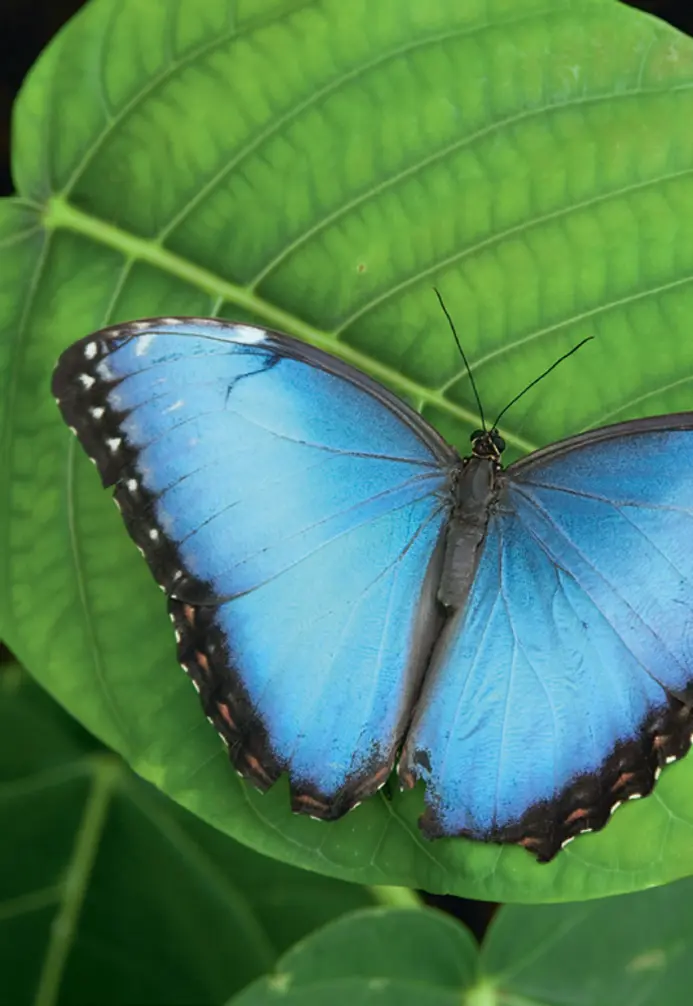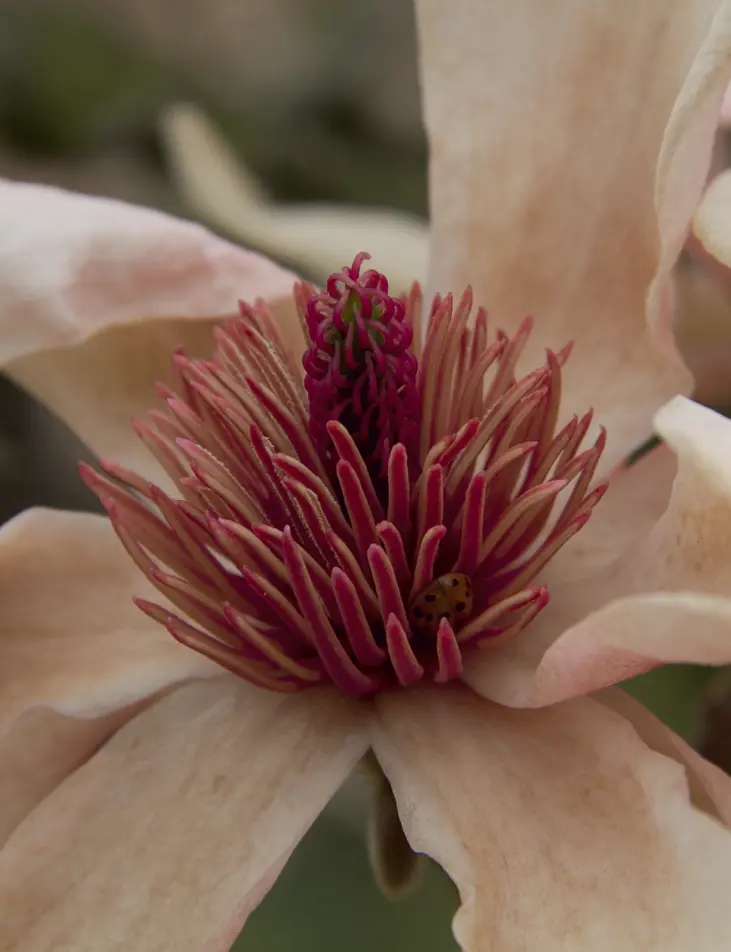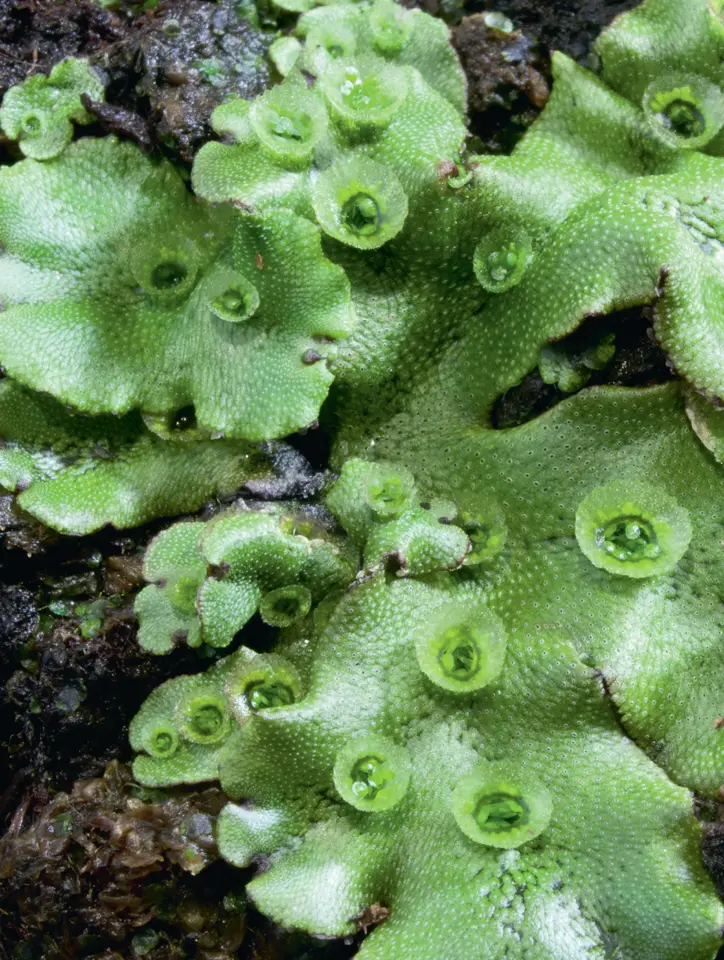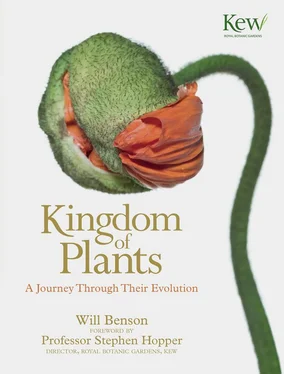
Blue morpho (Morpho peleides)
Plants today help support vast ecosystems of interconnected species.
© RBG Kew
Over millions of years plants have become increasingly defined and specialised, carving out their own niches on the surface of the planet; each one striving for the evolutionary equivalent of the limelight – a chance to reproduce and spread their genes. In the beginning of the journey we uncover the origins of photosynthesis, an elegant mechanism which revolutionised the way organisms could obtain energy, providing a powerhouse through which plants could grow and compete. In the next step, plants make a crucial leap out of their watery beginnings, as they moved onto the land. But it is from here that the botanical world really came into its own. Plants became tough and tall, developing structural wood that allowed them to reach new heights. They developed mighty anchoring roots and broad, air-pumping canopies. Skipping forward a few hundred million years we meet the rise of the first flowers, signalling the beginning of a great and ground-shaking love affair between insects and plants, setting in motion a course of events that would bind some plants to the animal world. From this point, the pace of the story picks up as we enter the age of rich biodiversity and intricate connections between Earth’s flora and fauna; we discover the extraordinary relationships between plants and animals, and we see that from one form of simple plant, many millions of diverse species have now evolved. And yet the most crucial chapters in the story of plants are still being written
From the early 1800s onwards countless expeditions set off to chart new territory and to collect rare and beautiful botanical specimens with which to fill elaborate glasshouses. This was to be the golden age of plant hunting, and with it began humankind’s fascination with the plant world. Today the spirit of these first pioneers remains in the world’s premier botanical gardens and research institutes. The biologists and ecologists who populate these centres have provided us with a far greater understanding of our planet’s biodiversity than ever before. Ultimately it is these botanists and conservationists who will ensure the survival of the world’s plant species.
* * *

Magnolia sp.
One of the many species that were brought to Europe and are now common.
© Will Benson
To discover the origins of the plant kingdom we have to visit the Earth three billion years ago. At this time a dark gas-filled sky looms ominously overhead, the air is thick and acrid from the smouldering funnels of volcanic activity, and the waters of warm, shallow tropical seas lap at the shores of recently formed magma islands. This is a time we know now as the Archaean eon. In the watery depths of these ancient oceans tiny single-celled organisms drifted through the murky sediments of the seas. These basic microscopic cells were early bacteria, and consisted of nothing more than a simple outer membrane containing just a few primitive proteins inside. Over time, these cells grouped together to form layers of slime across the ancient seabed.

Stromatolites
These fossils in Australia’s Shark Bay represent the earliest known life forms on Earth.
© Minden Pictures/SuperStock
These bacteria survived by absorbing near-infrared light from the sun’s rays that penetrated the ancient atmosphere. This light was used to convert the carbon dioxide and hydrogen-based organic chemicals that they had ingested from the water into sulphates or sulphur, providing them with nutrients. Although this basic chemical conversion may seem simple and insignificant, it was in fact the origin of all plant life we see on our planet today. This chemical conversion is the mechanism which all species of plant and animal on Earth, either directly or indirectly, now use as their ultimate source of energy. This was photosynthesis – the use of the light energy to manufacture vital organic food.
The first photosynthetic bacteria had bundles of light-absorbing pigments enclosed within their cell walls. These pigments were called bacteriochlorophylls, the predecessors of chlorophyll. The ability for these early cells to use energy from the sun to create organic compounds and sugars which could then be used for growth and movement was a major step forward in evolutionary terms. No longer would these Archaean bacteria be confined to absorbing the mere chemical scraps of nutrients available in the sediment. With their gradual radiation throughout the Archaean seas, the bacteria developed and adapted, and over hundreds of millions of years they evolved significantly.
Then, around 2.7 billion years ago, there emerged a further advance in these organisms’ energy-exploiting capabilities. Alongside the early bacteria, new cells appeared – the cyanobacteria. Now while the early bacteria were making use of the ‘invisible’ near-infrared light from the sun, the structure of the pigments in the cyanobacteria’s light-absorbing machinery had evolved to absorb visible light as a means of breaking down chemical compounds to produce food. To help them absorb this visible light even more efficiently they developed a far more varied range of photosynthetic pigments, called phycobilins and carotenoids, as well as several forms of what we know today as chlorophyll.
With the change in the wavelengths of light that these new pigments were able to absorb came a change in the precise chemicals that they could digest. For over 300 million years since the rise of photosynthetic bacteria, the by-product of photosynthesis had been sulphurous gases, but in the case of cyanobacteria the by-product was a simple yet vital molecule – oxygen.
So successful were the oxygen-pumping cyanobacteria in the prehistoric world that great colonies of them, many billions of cells strong, are now found fossilised in the layers of sediment which were laid down during the Archaean and Proterozoic eons. This record of life, captured as it was over two billion years ago, marks a critical juncture in Earth’s history. As the cyanobacteria went about their business absorbing carbon dioxide from the sea and churning out oxygen into the water, some of this oxygen began to make its way up into the atmosphere, where it accumulated in great clouds, many thousands of tonnes in weight. At the same time – and for reasons still not conclusively known – others gases such as hydrogen began to decrease in the atmosphere. Crucially, this reduction in atmospheric hydrogen allowed oxygen to start accumulating.

Liverworts
These may be the closest living relatives to the first plants to live on land.
© Tim Shepherd
Although they are not technically plants themselves, this so-called Great Oxidation Event earns cyanobacteria their place on the plant wall of fame. Oxygen is the third most abundant element in the entire universe, but until the intervention of these simple bacterial cells, Earth’s oxygen atoms were predominantly locked up in chemical relationships with other elements. Elemental oxygen is so chemically reactive that whenever it gets the chance it will bond to nearly any other available molecule, and in the Archaean and Proterozoic eons, there was certainly no shortage of available hydrogen, sulphur and carbon which it could bind to, creating water (H2O), sulphur dioxide (SO2) and carbon dioxide (CO2). But, critically, what cyanobacterial photosynthesis did was to split single oxygen atoms away from water molecules by using energy from sunlight, and then join two lone oxygen atoms together. By forming a partnership with an identical atom, these pairs of oxygen (or O2, as you’ll know them) had alleviated their want to bond to other chemicals through partnering up with one of their own. For the first time oxygen existed in a stable state, and this meant it could begin to increase in the atmosphere.
Читать дальше















